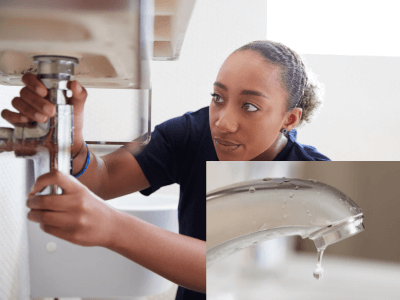
10 Ways To Fix Leaky Faucet: Your Step-By-Step Guide
A leaky faucet is not only annoying but can also waste a significant amount of water and lead to higher water bills. Fortunately, Fix Leaky Faucet is a common plumbing repair that many homeowners can tackle on their own with the right tools and knowledge. In this guide, Saint Pete Plumbing will walk you through the steps to fix leaky faucet, saving you money and preventing further water waste.1. Identify the Type of Faucet
Before you begin the repair, it’s essential to determine the type of faucet you have, as different types require different repair techniques. The four most common types of faucets are:- Compression Faucet: These faucets have separate hot and cold handles and are typically found in older homes.
- Ball Faucet: Found in many kitchen faucets, ball faucets have a single handle that controls both hot and cold water.
- Cartridge Faucet: These faucets have a single handle and use a cartridge to control the flow of water.
- Ceramic Disk Faucet: Similar to cartridge faucets, ceramic disk faucets also have a single handle but use ceramic disks instead of cartridges.
Identifying the type of faucet will help you determine the appropriate repair method.
2. Gather the Necessary Tools and Supplies
Before you start the repair, gather the tools and supplies you’ll need. Here’s a list of common items you may need:- Adjustable wrench
- Screwdriver (flathead and Phillips)
- Allen wrench set
- Replacement parts (such as washers, O-rings, cartridges, or ceramic disks)
- Penetrating oil (for stubborn parts)
- Plumbers tape (Teflon tape)
Having everything you need on hand will make the repair process smoother and more efficient.
3. Turn Off the Water Supply
Before you begin disassembling the faucet, it’s crucial to turn off the water supply to prevent any further leaks or water damage. Locate the shutoff valves under the sink and turn them clockwise to shut off the water. If there are no shutoff valves, you may need to shut off the main water supply to your home.4. Disassemble the Faucet
Once the water supply is turned off, you can begin disassembling the faucet to access the internal components. The specific steps will vary depending on the type of faucet you have:- Compression Faucet: Remove the decorative cap on the handle, then unscrew the handle using a screwdriver. Use an adjustable wrench to remove the packing nut, then remove the stem assembly.
- Ball Faucet: Remove the handle and dome assembly, then use pliers to remove the collar and cap. Once the cap is removed, you can access the cam assembly and ball.
- Cartridge Faucet: Remove the handle and decorative cap, then use pliers to remove the retaining clip. Once the clip is removed, you can pull out the cartridge.
- Ceramic Disk Faucet: Remove the handle and decorative cap, then unscrew the disk cartridge from the faucet body.
As you disassemble the faucet, be sure to keep track of the order of the parts for reassembly later.
5. Inspect and Replace Damaged Parts
Once you’ve disassembled the faucet, carefully inspect each component for signs of damage or wear. Common culprits for leaks include worn-out washers, O-rings, cartridges, or ceramic disks. If any parts are damaged or worn, they will need to be replaced.- Washers and O-rings: These are common causes of leaks in compression faucets. Replace any worn-out washers or O-rings with new ones of the same size and shape.
- Cartridges or Ceramic Disks: If you have a cartridge or ceramic disk faucet and notice leaking from the handle, the cartridge or disk may be damaged. Replace the cartridge or disk with a new one compatible with your faucet model.
6. Reassemble the Faucet
Once you’ve replaced any damaged parts, it’s time to reassemble the faucet in the reverse order of disassembly. Follow these steps:- Compression Faucet: Reassemble the stem assembly, packing nut, handle, and decorative cap.
- Ball Faucet: Reassemble the ball, cam assembly, collar, cap, dome assembly, handle, and decorative cap.
- Cartridge Faucet: Insert the new cartridge, replace the retaining clip, and reassemble the handle and decorative cap.
- Ceramic Disk Faucet: Screw the new ceramic disk cartridge back into the faucet body and reassemble the handle and decorative cap.
As you reassemble the faucet, be sure to tighten all screws and nuts securely to prevent any future leaks.
7. Turn On the Water Supply and Test
Once the faucet is reassembled, turn the water supply back on and test the faucet for leaks. Slowly turn the handle to both the hot and cold positions and check for any signs of dripping or leaking. If you notice any leaks, double-check that all components are tightly secured and properly aligned.8. Apply Plumbers Tape (Teflon Tape)
If you notice any leaks around threaded connections, such as between the faucet body and the spout or handles, you may need to apply plumber’s tape (Teflon tape) to create a watertight seal. Simply wrap a few layers of Teflon tape around the threaded area before reassembling the faucet.9. Consider Professional Help
If you’re uncomfortable with DIY repairs or encounter any difficulties during the process, don’t hesitate to seek professional help. A licensed plumber has the expertise and experience to diagnose and repair any issues with your faucet quickly and effectively.10. Preventive Maintenance
Once you’ve successfully fix leaky faucet, it’s essential to practice preventive maintenance to prevent future leaks. Here are a few tips:- Regular Inspections: Periodically check your faucet for signs of leaks or damage and address any issues promptly.
- Clean Aerators and Screens: Remove and clean aerators and screens regularly to prevent clogs and maintain water flow.
- Avoid Over-tightening: Be careful not to over-tighten handles or other components, as this can cause damage and leaks.
Fix leaky faucet is a relatively simple DIY repair that can save you money and prevent water waste. By following these steps from Saint Pete Plumbing, you can tackle the repair with confidence and restore your faucet to proper working condition. Remember to identify the type of faucet you have, gather the necessary tools and supplies, and turn off the water supply before beginning the repair. With a little time and effort, you can enjoy a leak-free faucet and a more efficient plumbing system in your home.
Contact us today for a quote and let us handle all your plumbing needs. Email us at services@saintpeteplumbing.com





